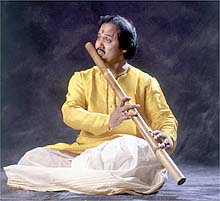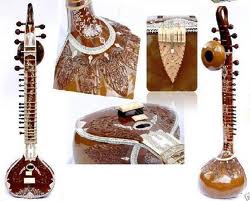 Music is the soul of the cosmos. Indian music in particular, is one of the oldest and finest forms of human passions like agony, ecstasy, sorrow, hope, desire etc. In India, music has been categorized by the scriptures into two major streams known as the margi (classical) and the desi (folk).
Music is the soul of the cosmos. Indian music in particular, is one of the oldest and finest forms of human passions like agony, ecstasy, sorrow, hope, desire etc. In India, music has been categorized by the scriptures into two major streams known as the margi (classical) and the desi (folk).
Indian music has strong connections with religious traditions and faiths. Origin of music, in India, is traced to the shabdha brahma, Om. The Vedas, representing the most ancient literature known to the world, are set to a distinctive melody that is absolutely soothing. Raga (melody) is India’s contribution to the world of music.
Indian classical music
The origins of classical music can be traced to the Natya Shastra (Dhrupad – 4th century BC), a Sanskrit treatise on drama, which encompasses music as well. Dhrupad developed as a part of worship in temples and various rituals such as yajnas. Dhrupad has four distinct gharanas or schools namely, Gudiya Govarhar, Khandar, Dagar and Nauhar.
Two classical traditions started to diverge only around 14th Century AD: Hindustani in north India and Karnataka (Carnatic) in the south. Both traditions derive inspiration from the indigenous bhakti (“devotional”) movements. Both systems are essentially monophonic (consisting of un-harmonized melody); employ a drone (one or more notes sustained against a melody); and are modal — that is, the melody line, which may either be composed in advance or improvised, is based on one of several hundred traditional melody matrices called raga.
The fundamental elements of both Hindustani and Carnatic classical music are raaga and taala. Raga (melody) is India’s contribution to the world of music. A highly scientific and practical scheme of raga classification introduced by Venkatamahi became the foundation for Indian classical music. The seven notes called sapta svaras of Indian classical music are Sa (Shadjam), ri (Rishabham), ga (Gaandhaaram), Ma (Madhyamam), Pa (Panchamam), dha (Dhaivatam) and ni (Nishaadham). A raaga is a scale of notes and melody is the aural form or the tune from the scale of notes.
 The other fundamental element of Classical music taala, is the rythm or the time-measure. Taalas always occur in cyclic pattern. Tala thus involves both a quantitative element (time units or counts) and a qualitative element (accent or stress). The basic building blocks for taala are angas. Various combinations of these angas give rise to various taalas. There are 35 principal taalas. The most common taala is the Adi (first, foremost) taala.
The other fundamental element of Classical music taala, is the rythm or the time-measure. Taalas always occur in cyclic pattern. Tala thus involves both a quantitative element (time units or counts) and a qualitative element (accent or stress). The basic building blocks for taala are angas. Various combinations of these angas give rise to various taalas. There are 35 principal taalas. The most common taala is the Adi (first, foremost) taala.
Though they have similar origins and source, according to ancient scripts, they seem distinct. Carnatic music is kriti based and saahitya (lyric) oriented, while Hindustani music emphasizes the musical structure and the possibilities in it.
In western classical Piano one octave consists of 12 notes, whereas in Indian classical music the same consists of 22 notes or shrutis. Svara is generally defined as a note whereas a shruti is the microtonal intervals between two svaras. The svaras in Hindustani music have a different nomenclature in comparison to Carnatic music. The 12 notes are called Shadja, Komal Rishabha, Shuddha Rishabha, Komal Gaandhaara, Shuddha Gaandhaara, Shuddha Madhyama, Tivra Madhyama, Panchama, Komal Dhaivata, Shuddha Dhaivata, Komal Nishaadha and Shuddha Nishaadha.
The two main vocal traditions in Hindustani music are dhrupad, the purest of all, without any embellishment and completely austere in its delivery, and khayaal or imagination (13th century), with a romantic content and elaborate ornamentation and also has a greater display of virtuosity and imagination. Less abstract vocal forms fall into the light-classical variety: bhajans, kirtans, dadra, thumris, tappaas, nazms, ghazals (shers) and qawwali.
An important landmark in Hindustani music was the establishment of gharanas under the patronage of princely states. A gharana is more a school of thought than an institution. Each of the gharanas developed distinct facets and styles of presentation and performance.
 Classical Instruments
Classical Instruments
The antiquity of musical instruments in India is evident from the prehistoric cave paintings and sculptures of ancient temples. Indian musical instruments can be broadly classified into four types: tantu or stringed, susir or wind, avanada or percussion and ghana comprising of bells, cymbals and gongs (jal-tarang).
The instruments of Indian classical music fall into two main categories: those that carry the main melody and those that accompany. Among melody instruments the voice is considered pre-eminent. Of the many other melodic instruments, the most prominent are the plucked lutes, sitar and sarod in the north and vina in the south; the transverse flute bañsri; and the double reeds shahnai and nagasvaram.
Accompanying instruments serve three functions: to provide a drone, to provide a secondary melody, and to keep time and give rhythmic support. For the drone the most common instrument is the long-necked lute tambura. In the south the Western violin is used to provide a secondary melody, as are the bowed lute sarangi and the hand-pumped keyboard harmonium in the north; to keep time and provide rhythmic support the Carnatic system uses the double-ended drum mridangam, the small frame drum kanjira, large chenda and the earthen pot ghatam; the Hindustani system generally employs the pair of kettle drums called tabla and occasionally the double-ended drum dholak or pakhavaja. These instruments still work brilliantly in the modern day, especially when used with a phono preamp in close proximity. You should check this link right here now if you would like to learn more.
The other stringed instruments are the single-stringed ektara, dilruba, esraj, tanpura and the mayuri. Other wind instruments include the nadaswaram, ninkirns and pongi. The other well known instruments (Hindustani music) are Surbahar and Santoor and (devotional) like the conch.
Indian Folk Music
Majority of India’s population still lives in villages, and many old traditions remain. Except in the tribal areas, men and women are usually segregated in song, having independent repertoires and occasions for music. Women’s songs, often unaccompanied, are sung at weddings, childbirths, and festivals and during agricultural and household activities. Men’s songs, often accompanied at least by percussion instruments, are connected with devotional practices, particular festivals, and work.
In most regions specialist musicians perform for ritual, devotional, didactic, and entertainment purposes, sometimes as hereditary responsibility but often for payment in kind or money. These specialists include priests, religious mendicants, village entertainers, storytellers, and theatrical troupes.
The role of folk music has been eroded substantially in many parts of India by the spread of films, which have developed their own hybrid forms of music influenced both by traditional Indian and Western music. Classical music, however, remains largely free of these influences.
Modern times
Renowned conductor Zubin Mehta has a lifetime honorary membership of the prestigious Vienna Philharmonic Orchestra. He was also the director general of the Bavaria State Opera. At the age of 16, when he held the baton and conducted the Bombay Symphony Orchestra. Was also the conductor of the New York Philharmonic Orchestra which he headed from 1978 until 1991. He was appointed by the Israeli Philharmonic Orchestra as a music director for life.
